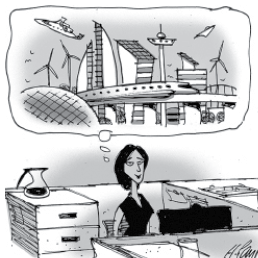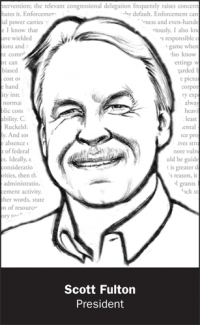WE ARE now into our second half-century of environmental and natural resources law. President Nixon signed the National Environmental Policy Act on New Year’s Day 1970, making it a convenient marker for the birth of modern environmental protection. NEPA has been called the Magna Carta of environmental law, and it heralded a new era of federal legislation, including the Clean Air Act later that year and a whole roster of laws to follow. The federal acts, along with complementary state environmental statutes, have substantially reduced pollution, resulting in cleaner air, water, and soils. And species like the brown pelican and bald eagle have been brought back from the brink.
While critical progress has been made, significant gaps in environmental laws remain if the country is to achieve a more sustainable economy. Understanding that, the authors of this article convened a diverse group of leading environmental law experts to consider how the field might need to evolve to meet current challenges and those expected over the next decades. We characterize this effort as “Reimagining Environmental Law.” In many ways, it means as well reimagining the future.
Toward that end, ELI and George Washington University Law School convened two dialogues, first at the Wingspread Conference Center in Racine, Wisconsin, in March 2019, and second at Airlie House Conference Center in Warrenton, Virginia, in November 2019. Both centers have been settings for environmental conferences for decades, with Airlie House hosting a conference in September 1969 that recommended the creation of ELI. (Information about the meetings and the attendees can be found at https://www.eli.org/environmental-governance/reimagining-environmental-law.) This article reflects the discussions at Wingspread and Airlie House, subsequent discussions with participants, and research conducted by ELI and GW Law.
In consultation with our experts, the authors concluded that among the key challenges remaining for environmental law are climate change and decarbonization, nonpoint sources of pollution, materials conservation and reuse, and ecosystem degradation and biodiversity loss. In addition, environmental justice presents both an area of needed focus alone as well as attention in cutting across all the other challenges.
The climate change problem is well-known and well-documented. The participants saw the major challenge for environmental law as finding a way to support dramatic decarbonization of the economy to avoid potentially catastrophic impact of warming and supporting needed adaptation to change. While the pathways for a transition to a low-carbon economy are known, reaching the goal of 80 percent emissions reduction by 2050 will require legal changes at all levels of government, as well as accompanying economic, political, and social changes.
Essential to the transformation needed is an economy-wide price on carbon to provide the economic incentives to make the shifts necessary to reach zero emissions. This means imposing a direct cost on each ton of greenhouse gas emitted. To accomplish this, policymakers must create a system at the national level to achieve the necessary economy-wide shifts. The participants did not express a clear preference for a tax or a trading system that caps emissions from GHG sources, though an internationally agreed system would be preferable. Any such pricing or trading system will also need to mitigate the disproportionate effect it will have on those with lower incomes, due to the higher costs of fossil fuels coupled with higher proportions of income spent on energy. It likely will also require regulatory measures to assure that environmental justice communities do not continue to disproportionately bear the risks associated with co-pollutants, like sulfur dioxide and mercury.
Given the decades-long effort to place a price on carbon and the urgency, immediate action is needed using the tools already available to reduce GHG emissions. The nation will need to address this issue across the economy through a comprehensive approach like those identified in ELI Press’s Legal Pathways for Deep Decarbonization book, which lists more than a thousand recommendations for legal instruments covering all forms of GHGs and how they are generated and released.
We also need a comprehensive and just policy for adapting to the risks — and impacts — of climate change and for helping communities become resilient. This will require an appropriate model for assessing risk. Decisions must be based on the possibility of the uncertain but potentially massive catastrophic outcomes related to natural disasters, sea-level rise, drought, and biodiversity loss. Many of these processes will require legal tools, like the model laws being produced by volunteer attorneys based on the recommendations in Legal Pathways, but others will require public investment such as transit projects, and in making buildings safer, healthier, and more energy efficient. Electrifying and investing in grid updates will also be essential in this effort, creating a more robust, resilient, and efficient network. Government agencies need to plan for how they will deliver essential services amidst climate disruptions, and how they will coordinate with partners at other levels of government. In addition to significant adaptation actions, the law must account for the liabilities associated with unintended consequences of adaptation measures.
Federal, state, local, and tribal governments need to remove subsidies, including tax breaks and other incentives, for fossil fuels and carbon-intensive industries. These governments will also need to reduce or remove regulatory barriers related to decarbonization of the economy while promoting social equity at every stage and level.
Government policies are needed to provide incentives for innovation and investment toward a carbon-free future. This will be particularly important in the absence of a price on carbon to promote development of the necessary technologies. Means to remove or sequester carbon from the atmosphere may be necessary if mitigation efforts do not advance at a sufficient pace.
An effective climate governance regime will require the engagement of the private sector in a multi-tiered system with distributed roles and accountability mechanisms. The regime must capitalize on and encourage private-sector initiatives to meet climate change goals. This can include supply chain systems that rely on a variety of approaches, including certification, auditing, labeling, and reporting programs enforced through contracts.
An equity lens will be critical in designing these polices to ensure that affected and especially vulnerable communities are meaningfully involved in designing and implementing these measures. If policies are designed to protect against the greatest potential risk, in many cases this will result in just outcomes. An updated and enhanced conception of the duty of care in both government and the private sector will help to facilitate this.
THE nation has made major strides in controlling water pollution from point sources. But many of the sources of impairment to water quality are from nonpoint sources — runoff and discharges from areas of land and operations that are not subject to direct federal regulation under the 1972 Clean Water Act. Even though these uncontrolled sources of pollution were recognized in the statute, they were not regulated because of concerns with federal legislative intrusion on state and local land use prerogatives and solicitude for such industries as agriculture, forestry, and land development.
The Wingspread and Airlie House participants preferred a more watershed-health-focused system over the status quo, which concentrates permit-by-permit on individual sources and on effluent limits on pollutant discharges. An alternative future could be far more focused on land quality and water quality results.
Given the major contribution of diffuse sources to the remaining water pollution problems, a new sense of urgency is needed for dealing with it. One way to accomplish this result could be to recharacterize these sources as “uncontrolled pollution” rather than using the innocuous term nonpoint pollution. The public and institutional motivation necessary to support advancement in law needs to be defined as achieving better environmental and public health outcomes — not controlling nonpoint sources.
State regulators should create a new structural framework for dealing with uncontrolled pollution. Simply relying on the current state water quality and waste load allocation framework has not proven effective. This new framework should capture sectors that have previously escaped requirements to reduce uncontrolled pollution. It should also focus on watersheds with major, recurrent pollution threatening public health and welfare.
Legislators can also consider funding and relying on big data, and making it publicly accessible. A great deal of data exists on water quality and more will become available as monitoring technology advances and is used by citizens. This will make it possible to define and track progress toward watershed outcomes. Sharing of data on public platforms and integration of ecological information with water quality, discharge data, geo-siting of best management practices, remote sensing, and biological sampling should be encouraged and supported.
At the federal level, officials should provide key actors with the power to create change by matching the best tool to the source of impairment. Policymakers should inventory effective regulatory and non-regulatory approaches and target these to sectors, watersheds, and problems where they have been proven. EPA or others should construct a database of tools used by the states, federal programs, the private sector, and others, and determine how these can be applied to different forms of uncontrolled pollution in different types of watersheds and settings. This resource could further be backed by supporting and funding integrated water management planning, and making funding available for implementation of the tools.
At both levels of government, policymakers should link federal and state procurement to effective management of uncontrolled pollution in the supply chain. This approach recognizes that government funding is substantial in the acquisition of food and fiber, materials, energy, and development. The reimagined approach would expressly provide for disclosures and certifications and perhaps pollution controls as conditions related to receiving funds.
All agencies at the national level need to require that federally funded land and water and development projects, and all authorized activities on federal lands, must result in net water quality improvements — or at least restoration to no net loss of water quality where there is no opportunity to achieve a net improvement.
THE European Union in its Circular Economy Plan noted, “There is only one planet Earth, yet by 2050, the world will be consuming as if there were three.” According to the United Nations, “In 2017, worldwide material consumption reached 92.1 billion tons . . . a 254 percent increase from 27 billion in 1970, with the rate of extraction accelerating every year since 2000. This reflects the increased demand for natural resources that has defined the past decades, resulting in undue burden on environmental resources.”
The United Nations’ Sustainable Development Goal 12 deals with production and consumption and notes that achieving its goal requires urgent reduction of the world’s “ecological footprint by changing the way we produce and consume goods and resources.” SDG 12 points out that “efficient management of our shared natural resources, and the way we dispose of toxic waste and pollutants, are important targets to achieve this goal. Encouraging industries, businesses, and consumers to recycle and reduce waste is equally as important.” Materials consumption is particularly challenging in the United States. In 2017 U.S. per capita materials consumption, including fuels, was 42 percent higher than Europe’s. Despite the increasingly clear adverse impacts of unsustainable materials use, the issue has received relatively little attention in U.S. environmental law.
The Wingspread and Airlie House participants built on work by the leading advocates of the circular economy, the World Resources Institute and the Ellen McArthur Foundation. The participants reimagined materials conservation and use to include a number of elements. With growing corporate, government, and nongovernment interest in the idea of a circular economy, the participants thought now is a good time to convene a national dialogue to discuss how to move to such a system in the United States.
Extended producer responsibility, or EPR, at the national level would create a level playing field across the country. A national EPR for electronics waste would help reduce environmental impacts and could make it easier for businesses to set up systems.
A national GHG policy that establishes a price on carbon would be important beyond just climate change by helping drive product redesign and reductions in materials use. A price on carbon could drive business innovation by providing a financial incentive to look carefully at energy inputs needed to extract new resources and manufacture and transport products, and to find ways to reuse them.
Federal procurement rules could be redesigned so that criteria favor products and services that are consistent with a circular economy. Further, as part of the economic recovery effort, the federal government is likely to spend a great deal on infrastructure. As a result, the new administration can have a major impact on responsible production and consumption by taking materials conservation and circular economy principles into account in procurement, perhaps through executive orders that build on available authority. Such changes could model desired behavior for state governments, universities, and other large procuring organizations.
Resource Conservation and Recovery Act regulations could be revised to reflect the circular economy hierarchy, which goes beyond the traditional reduce, reuse, recycle paradigm to include preventing the use of resources in the first instance, encouraging repairing and refurbishing, and supporting remanufacturing and repurposing. Model legislation could be developed for states to adopt this new circular economy waste hierarchy.
Materials conservation could be added as a factor to be considered in NEPA analyses. The White House Council on Environmental Quality could contribute to responsible production and consumption by providing guidance to agencies on how to consider materials use and conservation in environmental impact review.
Policymakers can explore the possibility of “fate labelling” for consumer products, so that purchasers can make more informed decisions. This could be done using QR codes or through systems in use or planned in the European Union.
HEALTHY populations cannot exist without healthy ecosystems. Driven primarily by anthropogenic activities, destroyed and degraded ecosystems threaten critical resources in significant and varied ways. Land, ocean, and freshwater systems are all affected. While legal and policy efforts have attempted to address the problem through species- or resource-specific mechanisms within geopolitical borders, the lack of coordinated efforts built around ecosystem-based solutions has meant the problem continues relatively unchecked. Without humanity changing current production and consumption patterns, along with precipitous population growth and unsustainable practices, trends will continue to worsen.
Healthy habitats provide untold benefits, sometimes called ecosystem services, which must be adequately preserved. Responses to these challenges must be direct and swift to avert the most significant impacts of development.
At least eighty countries have adopted policies to help ensure any impacts to biodiversity or ecosystem services from development projects are offset by mitigation, an approach known as “no net loss.” One important goal of the no-net-loss method is to make sure any populations affected by the development project and associated mitigation are not left worse off, but are ideally better off after the plans are completed.
In the United States, no federal statute focuses exclusively or directly on mitigating ecosystem degradation. Generally, domestic environmental laws focus on addressing a single issue rather than on ecosystems comprehensively. Unfortunately, these policies often do not account for the complex and interdependent nature of ecosystems. Moreover, these issues are typically managed based on short-term goals and primarily within distinct political and jurisdictional boundaries that do not necessarily reflect the scope of targeted resources. Even when governmental bodies work together on a project or program, their mandate and funding allocation falls short of long-term ecosystem restoration.
Policies at the federal, state, and local levels that emphasize no net loss of ecosystem services are needed to ensure these functions are preserved. This could be achieved by building on existing programs. An immediate action that could provide impetus to such a policy would be to revive the “Incorporating Ecosystem Services into Federal Decisionmaking” memo, issued jointly by the Office of Management and Budget, CEQ, and the White House Office of Science and Technology Policy in 2015. This memo called on “agencies to develop and institutionalize policies to promote consideration of ecosystem services . . . in planning, investments, and regulatory contexts.”
Policymakers should revise their environment and natural resources management frameworks with a goal of adopting a more holistic approach that prioritizes local ecosystem-level decisionmaking. This includes enacting federal legislation that requires no net loss of ecosystem services and encourages local and state-level ecosystem management. The framework would build on the existing approach to wetlands management but would provide expanded application and account for a wider array of natural benefits. Legislation should include provisions for grant funding for research and data collection, and for the development of multi‐stakeholder, consensus‐based ecosystem management. For example, federal actions subject to review under NEPA could shift focus from considering project impacts to ecosystem services impacts. Local and state land use decisions could build upon precedent set with mitigation banking under the Clean Water Act.
It is critical to emphasize that this approach could become a major equity concern if mismanaged. Communities must be involved so that the damages and benefits are spread justly across and within communities. This is especially true when addressing the legacy of discrimination faced by environmental justice communities and determining what damage is permissible under a no-net-loss framework. Making these decisions and processes more local provides an opportunity to protect residents from this potential concern.
Federal changes should be bolstered by efforts at the state level, including through revising or adopting state-level NEPA laws to include requiring an analysis of how a project will affect ecosystems and ecosystem services in the long term.
Policymakers at all levels should reform governance structures to complement ecological boundaries. Ecologically oriented governance will prioritize the entire habitat or watershed and more effectively integrate natural systems and environmental media to better ensure impacts are accounted for and degradation is mitigated. That reorganization will necessarily require inter- and intra-governmental cooperation at all levels — federal, state, local, and tribal. Throughout, these techniques should involve communities and incorporate traditional ecological knowledge.
To better align ecology and governance, the U.S. Fish and Wildlife Service should be given the authority to work with multiple levels of government and private entities to negotiate land use plans that protect or enhance ecosystem services. Such authority would be particularly useful when endangered species and critical habitat are at issue, providing a protective mechanism with widespread stakeholder engagement. Bringing together all parties with jurisdiction within a given ecological context with oversight by FWS may enhance cooperation and response to ecosystem management challenges.
New and existing regional governance bodies could be provided with “pre-authorization compacts” akin to water compacts and regional electricity grid agreements to address different parts of the same environmental event or phenomenon. While arguably less comprehensive than ecosystem-level management, compacts may be more feasible and can still help facilitate responsive coordination to environmental impacts.
INJUSTICE is manifest in several dimensions across the landscape of U.S. environmental law and policy, at all levels of governance, from local actions to state and federal decisionmaking. Communities of color and low-income communities often experience higher releases of pollutants, siting of undesirable land uses, and lack of access to environmental benefits and amenities. These same communities already bear a substantial health, social, and economic burden from pollutants, poorer access to healthy living spaces, effects of poverty, and inadequate access to health care. Even where pollutants and practices are similar to those experienced elsewhere, the addition of these burdens to existing health, socioeconomic, and community conditions can have greater cumulative adverse impacts on such environmental justice community residents.
At the federal level, the framework for environmental justice has been almost entirely based on executive orders and agency memoranda, rather than on enforceable laws and regulations. Environmental justice gained formal federal recognition in Executive Order 12898, “Federal Actions To Address Environmental Justice in Minority Populations and Low-Income Populations,” issued by President Clinton in 1994, and still in effect today.
But there is still no focused and specific federal statutory foundation for environmental justice. EPA’s Office of Environmental Justice has identified various provisions in federal law that can be cited by federal agencies when they desire to support an EJ-related decision. OEJ also has developed EJScreen, a mapping and information tool, to assist agency decisionmakers and permit applicants in identifying communities and implementation factors where cumulative adverse impacts may occur. In the absence of legal drivers, however, this kind of tool cannot alone produce substantive change.
A number of states have enacted environmental justice legislation or adopted regulations or policy instruments to give EJ a greater role in decisionmaking. California’s CalEnviroScreen, for example, enables decisionmakers to identify environmentally burdened communities and create indices used for permitting, enforcement, and funding prioritization.
THE Wingspread and Airlie conferees recognized the need for legal processes to obtain just outcomes and not merely more accessible procedures — especially given cumulative impacts on EJ communities. They noted that EJ initiatives, in order to be effective, must be thoroughly integrated into all decisionmaking affecting the environment. It cannot simply be an add-on or check-off at the end of a decision process.
A minority of states already have constitutional rights related to the environment, but only a few of these are self-executing and enforceable by members of the public and communities. Environmental justice may be advanced by promoting adoption of such state amendments. In those states that already have only hortatory environmental amendments on the books, the approach would seek appropriate further amendment to enhance enforceability. This approach would require careful drafting of amendments to ensure that they are self-executing and hence enforceable without the need for additional state legislation. It would also need to create or recognize a public trust in the natural resources of the state, including clean air, pure water, biological resources, and publicly owned lands and resources, and state a human right to a clean and healthy environment.
Federal and state legislation that embodies important EJ procedural and outcome elements should be adopted. Such legislation can include codification of E.O. 12898 elements, including definitions of minority and low-income communities and disproportionately high and adverse impacts, as well as meaningful engagement and other provisions. The laws could require tools such as EJScreen. There could be other requirements for new development in communities overburdened by pollution to offset any projected increases in pollution loadings, with reductions in the existing pollution inventory on a 1:1 or net-reduction basis. Statutes could mandate disclosures of information by applicants or operators that will enable communities to participate in review processes and take action to protect their health and resources. They could remove legal barriers to public participation in decisions affecting EJ communities. Finally, the laws could create a private right of action for enforcement of civil rights.
For the private sector, policymakers could promote and encourage private governance and corporate commitments and accountability mechanisms for environmental justice. Companies and groups of companies and organizations can develop best practices and codes of conduct that firms integrate into their decision processes, management systems, supply chain requirements, and internal and external accountability mechanisms.
As the country embarks on the second half-century of the modern environmental law era, it is important to recognize both the successes of the past as well as the issues for which environmental law has not been as successful. The Reimagining process was designed to focus on some of the critical issues to ensure that policymakers seriously address remaining problems and inequities. We hope that when our successors look back on environmental law at 100, they will be able to identify significant progress in the areas identified by the Wingspread and Airlie House participants as critical issues. R&P
John Pendergrass is ELI’s vice president for programs and publications, and leads the Research and Policy Division. ELI Visiting Scholar LeRoy Paddock is distinguished professorial lecturer in environmental law at George Washington University Law School.
———
The authors thank all the Wingspread and Airlie House participants, who are the true authors of this article, and James McElfish, Sandra Nichols Thiam, and Jarryd Page, who drafted the white papers that were excerpted here.







